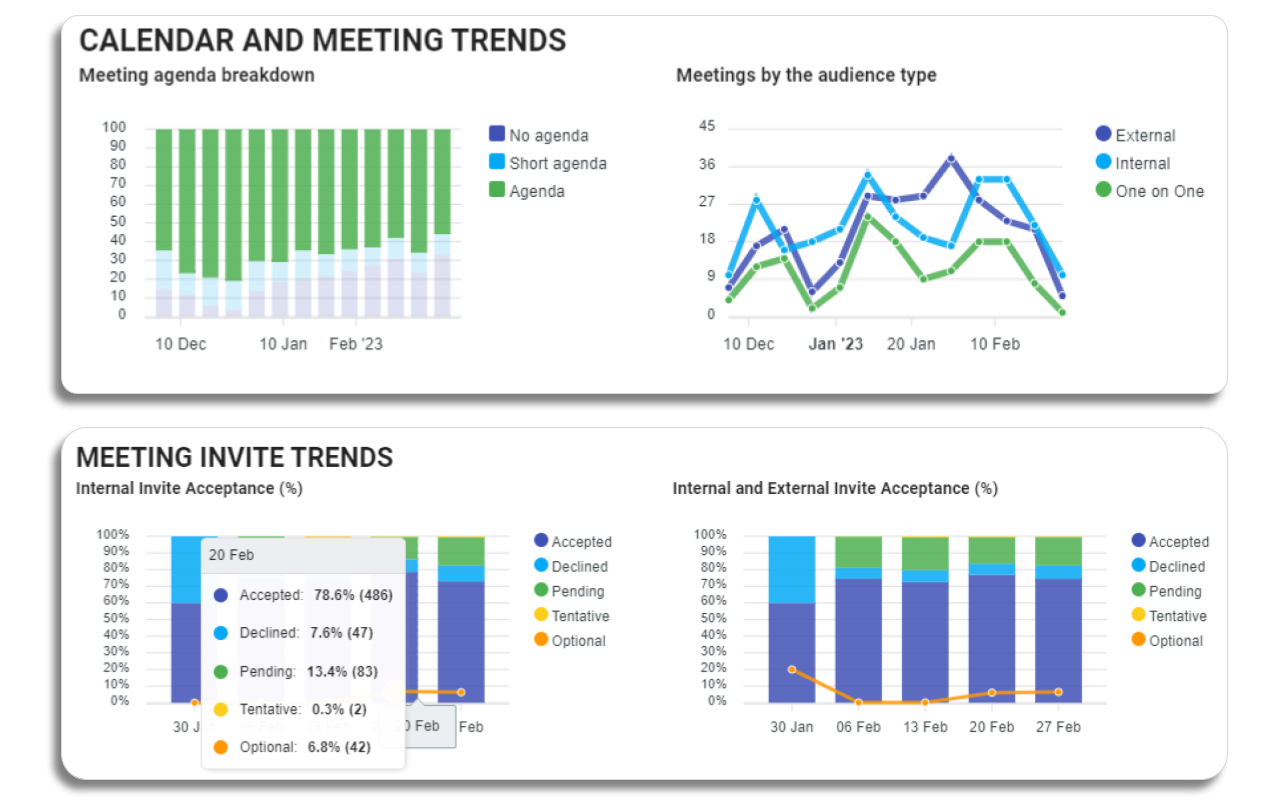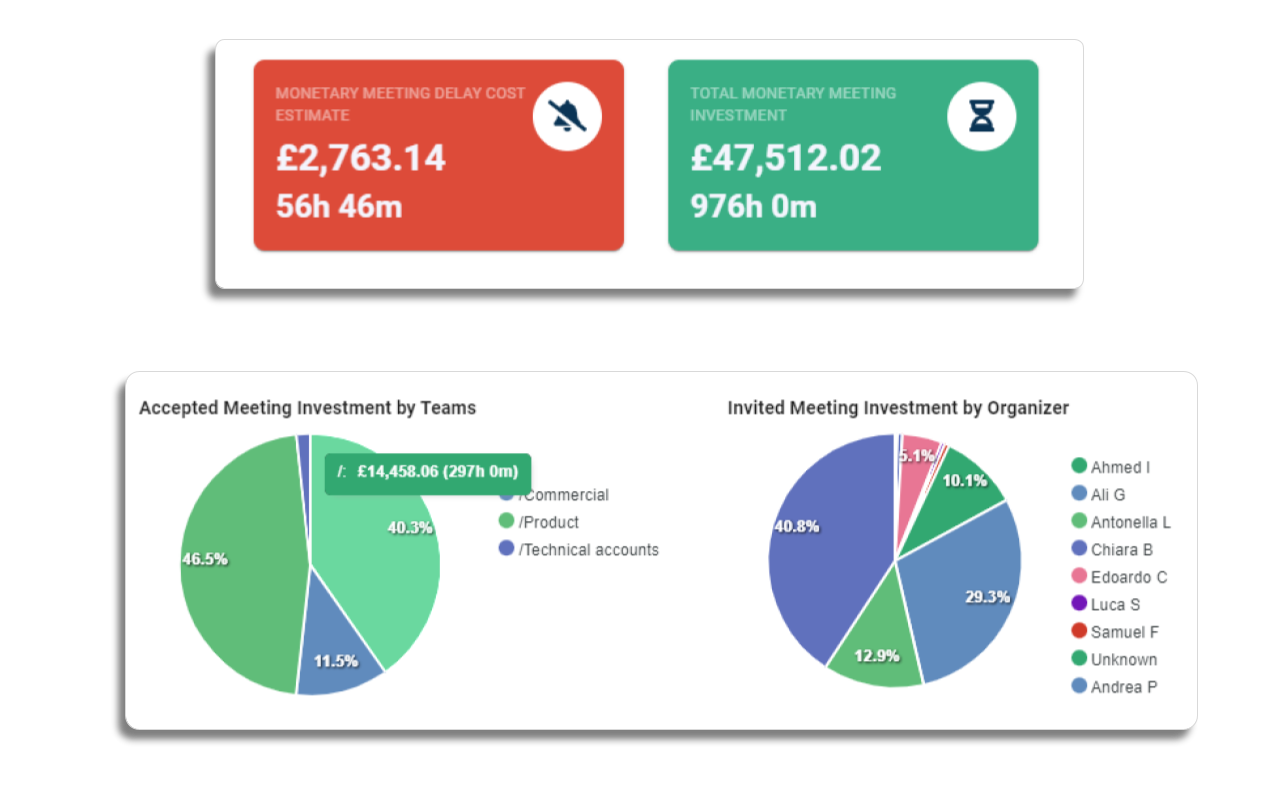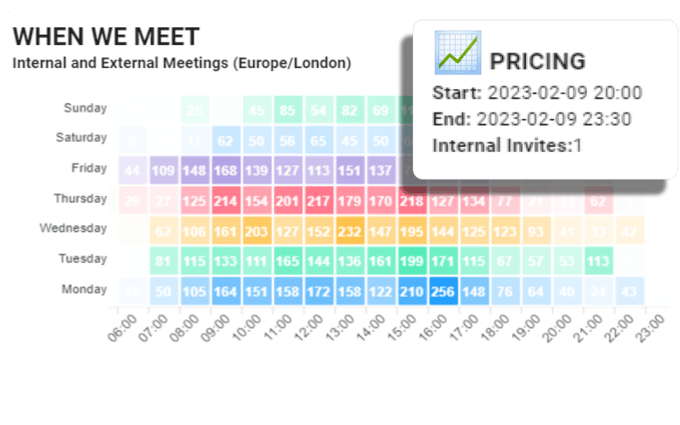In the realm of productivity and efficiency in the workplace, one tool has been steadily gaining recognition for its ability to provide valuable insights - calendar analytics. As our workdays become increasingly scheduled and our calendars filled with back-to-back meetings, understanding how we spend our time has never been more important.
According to a study by Atlassian, the average employee attends 62 meetings per month, with half of these meetings considered as wasted time. That's a staggering 31 hours spent in unproductive meetings every month! Furthermore, the study found that employees face 56 interruptions a day on average, and spend two hours recovering from these distractions.
Read more: "How to reduce interruptions at work"
In this context, the importance of effective time management and scheduling becomes clear. This is where calendar analytics comes in. By examining our calendars, we can gain a deeper understanding of our work habits, identify areas for improvement, and ultimately, boost our productivity.

In this article, we'll delve into the world of calendar analytics, exploring what it is, why it's important, and how you can leverage it to optimize your workday. We'll also introduce you to Flowtrace, a powerful tool that can assist you in this process. So, let's get started and take a step towards reclaiming our time and improving productivity.
What is Calendar Analysis?
Calendar analysis is a process that involves examining and interpreting data from calendars to gain insights into how time is being spent. It's a form of data analysis that focuses specifically on calendar data, including meeting times, durations, participants, and more.

The goal of calendar analysis is to understand patterns and trends in scheduling and time management. This can help identify issues such as meeting overload, inefficient scheduling, or lack of time for focused work. By analyzing calendar data, organizations can make informed decisions to improve productivity and efficiency.
For example, if an analysis reveals that a significant amount of time is being spent in meetings that don't contribute to key objectives, steps can be taken to reduce these meetings and free up time for more valuable activities. Moreover, one significant factor influencing meeting productivity is the use of meeting agendas. By leveraging calendar analytics, you can effectively track the adoption of similar best practices to improve meeting effectiveness. Alternatively, if the analysis shows that certain times of day are particularly productive, these can be protected as 'deep work' periods.

In essence, calendar analysis is a tool for making visible the invisible patterns of work. It's about making the most of our most precious resource - time.

The Importance of Calendar Analysis
In the quest for workplace productivity, understanding how we utilize our time is paramount. Calendar analysis plays a pivotal role in this process, offering insights that can transform the way we work. Here's why it's so important:
Understanding Time Usage
In today's work environment, where multitasking is the norm and calendars are filled to the brim, understanding how we spend our time is crucial. Are too many hours being lost to unproductive meetings? Is there enough time allocated for deep, focused work? By providing answers to these questions, calendar analysis can help identify inefficiencies and areas for improvement.
Better Planning and Scheduling
Calendar analysis facilitates better planning and scheduling. By understanding the patterns and trends in our calendars, we can make more informed decisions about how to schedule our time. This can lead to improved productivity and a better balance between meetings, collaborative work, and individual focused work.

Fostering Transparency and Accountability
Calendar analysis can help foster a culture of transparency and accountability. By making visible how time is spent, it encourages individuals and teams to be more mindful of their time management. This can lead to a more productive and efficient work environment.
In short, calendar analysis is not just about understanding our calendars - it's about using this understanding to improve productivity and make better use of our time.
How to Analyze a Calendar
Analyzing a calendar involves several steps:
-
Collect Calendar Data: Gather information about meeting times, durations, participants, and more from your calendar application.
-
Identify Key Metrics: Determine the metrics you want to analyze, such as the number of meetings per day or week, the average duration of meetings, and the proportion of time spent in meetings versus other activities.
-
Analyze the Data: Look for patterns and trends in your key metrics to understand your current time usage.
-
Make Adjustments: Based on your analysis, make changes to your schedule to improve efficiency and productivity.
-
Monitor and Adjust: Regularly review your calendar and time usage, making adjustments as needed to optimize your schedule.

Tools like Flowtrace meeting analytics can automate much of this process, providing comprehensive calendar analytics to help you understand and optimize your time usage. We have also written a comprehensive guide on how to conduct a calendar audit for you to get started.
Introducing Flowtrace for Calendar Analysis
While manual calendar analysis can provide valuable insights, it can be time-consuming and complex. This is where Flowtrace comes in. As a powerful calendar analytics tool, Flowtrace automates the process, providing you with in-depth insights into your time usage.

Flowtrace collects data from your calendar and analyzes it to provide you with actionable insights. It identifies patterns and trends in your scheduling, helping you understand how your time is being spent. Whether it's highlighting meeting overload, identifying prime times for focused work, or revealing inefficiencies in your scheduling, Flowtrace provides the insights you need to optimize your workday.
In essence, Flowtrace is more than just a calendar analytics tool - it's a comprehensive solution for improving workplace productivity. By providing clear, actionable insights into your work habits, Flowtrace empowers you to make informed decisions and take control of your time.
Take Control of Your Workplace Calendar
In today's busy work environment, understanding how we spend our time is more important than ever. Calendar analysis provides the insights we need to make informed decisions about our schedules, helping us to optimize our time and enhance our productivity.
While manual calendar audits can be beneficial, tools like Flowtrace offer a more efficient and comprehensive solution. By automating the process of calendar analysis, Flowtrace allows you to gain deeper insights into your time usage, helping you to identify inefficiencies, reduce meeting overload, and create more time for focused work.
In essence, calendar analysis is a powerful tool for improving workplace productivity. Whether you're looking to make better use of your time, reduce the number of unproductive meetings, or create more opportunities for deep work, calendar analysis can provide the insights you need to achieve your goals.
